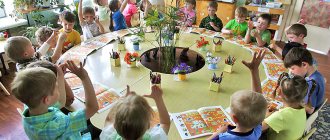Using layouts in environmental education of preschool children
Using layouts in environmental education of preschool children
The author is Ishmukhametova Liana Ildusovna, teacher of the speech therapy group at MBDOU kindergarten No. 36, village. Mesyagutovo municipal district Duvansky district of the Republic of Bashkortostan.
Nowadays, the environmental problem is the most pressing and is attracting more and more attention. Labor activity and lifestyle of modern society have become a powerful transformative force that affects the biosphere and disrupts the course of its natural evolution. A way out of the environmental crisis, scientists note, is impossible by technical means. Environmental education is a necessary condition for overcoming the consequences of negative impacts on the environment and a factor in the formation of an individual’s ecological culture as a regulator of relations in the “person – environment” system.
Preschool childhood can rightfully be considered the beginning of the formation of an individual’s ecological thinking, since during this period the foundation of a conscious attitude to the surrounding reality is laid, vivid, emotional impressions are accumulated that remain in a person’s memory for a long time, and sometimes for a lifetime. One of the conditions for the implementation of the environmental education system in preschool educational institutions is the correct organization and ecologization of the developmental subject environment, which should contribute not only to cognitive, aesthetic and moral development, but also to the formation of environmentally literate behavior in nature, safe for both nature itself and the child.
According to the requirements of the Federal State Educational Standard, the subject-spatial environment must provide the opportunity for communication and joint activities of children and adults, and ensure the maximum realization of educational potential. Materials that activate cognitive activity are required in the equipment. Such materials are layouts. Today we will talk about environmental layouts.
Layout – a reduced model of an object (forest, mountains, field, lake, volcano, solar system, etc.).
In the process of developing a game with layouts, the following tasks are solved:
- conditions are created for enriching children’s ideas about nature and the conditions for life of the plant and animal world;
-develops cognitive interest in living nature, emotional responsiveness and curiosity;
- skills of correct behavior in nature are formed;
- goodwill, responsiveness to the natural world, and careful attitude towards it are cultivated.
In early preschool age, children are just beginning to form ideas about living nature. Simple layouts and models created by the hands of teachers form initial ideas about natural objects. But it is not the presence of the layout that shapes it, but the ability to communicate with it, the game. With younger preschoolers, work involves examining finished products and manipulating them. A conversation about nature or a natural object that the model depicts. In the life of older preschoolers, director's play with small toys occupies a large place, when the child creates an imaginary situation, invents an event with characters, identifying himself with them, performing one of several roles, and modeling real social relationships in a playful form.
Layout "Waterfall"
Layout "Mountains"
Layout "Lake"
Layout “Winter Forest”
Layout "Beehive"
Creating an anthill layout
Thus, we consider prototyping as an environmentally oriented activity that helps consolidate ideas about the natural world, allows one to transform acquired knowledge into play, saturating children’s lives with new impressions and stimulating children’s creativity. With the help of models, we form an understanding among preschoolers that all living beings need certain living conditions that satisfy their needs.
Making a didactic manual on ecology and the environment
handicrafts on ecology, teacher Kovaleva E.B. Novosibirsk, 2017
Making a didactic manual on ecology and the environment
together with younger schoolchildren.
Explanation.
A very convenient teaching aid for primary schoolchildren, such as the “Cashbox of Letters and Numbers” with special slots for cards with letters and numbers. The Letters and Numbers Box helps first graders learn letters and numbers; helps to form words syllable by syllable and perform simple arithmetic operations. Such aids are visual, develop and strengthen children’s visual and motor memory. The box of letters and numbers is used in mathematics, Russian language and reading lessons in elementary grades. But for lessons on the world around us, there are no such universal aids. I propose to make, together with schoolchildren, a didactic manual on the world around us for first-graders from cardboard.
Purpose and objectives of the lesson
: 1. Educational: children must understand the change of seasons, be able to list the seasons, identify spring natural phenomena, understand the useful activities of people in the spring. 2. Developmental: the teacher needs to develop children’s interest in nature and manual labor. 3. Educational: a teacher can instill in children a love of nature and work; foster friendly interaction in the team; teach each other to help each other.
Expected results:
a set of didactic teaching aids on ecology, made by yourself. Schoolchildren will acquire the ability to glue, cut, compare, perform actions in the correct sequence, reflect on natural phenomena, and determine the change of seasons by signs. These cardboard crafts can be used in didactic educational games during lessons on the world around us.
Materials:
cardboard, drawings, colored pencils, scissors, glue stick, plain paper envelopes, tape.
Lesson topic:
Spring came. Similar classes can be conducted on approximate topics: “Winter is an adventure,” “Autumn is a time for full pantries,” etc., selecting appropriate pictures.
Contents of the lesson:
In spring nature wakes up. The sun is shining brighter and the snow is beginning to melt. Spring drops are ringing! The day is getting longer and the night is getting shorter. It's getting warmer. The first spring rain drips from the clouds. Early grasses are sprouting and primroses are blooming. Buds are blooming on the trees. The first migratory birds arrive. And the schoolchildren have already prepared cozy houses for them - birdhouses. Birds will hatch their chicks in birdhouses. The coming of spring is the awakening of nature after a long winter.
For the lesson, schoolchildren can learn several poems and riddles about spring.
Progress
STEP #1.
We choose our favorite picture about nature in children's magazines. We chose from the archived issues of the magazine “Veselye Kartinki” the drawing “Spring has come” by the artist I. Savina.
STEP #2.
We print several copies of this picture on A4 sheets on a color printer. If there is no color printer, then print it on a black and white printer and color the drawing with colored pencils. Glue the sheets onto cardboard.
STEP #3.
Cut off the landscape part of the picture from the bottom. We make slits in the cardboard in the designated places of the picture. Separately cut out each object or element of the landscape from the bottom of the picture. Do not cut off the scallops on the cards, but check that they fit well into the slots in the picture. We put all 7 cut out cards with objects into an envelope (sun, bird, birdhouse, cloud, lily of the valley, grass, tools).
STEP #4.
We glue the envelope on the back of the picture onto the cardboard.
Application of the manual in the game.
After a conversation with first-graders about spring natural phenomena, the teacher divides the children into teams of two per team. One student holds the picture with both hands so that all classmates can clearly see it. The second student takes cardboard cards with objects - signs of spring - from the envelope and holds them in his hands. At the teacher’s command, children must quickly and correctly distribute the cards with signs of spring into places and insert them into the slots correctly. The teacher determines the winning team, consisting of two students, and counts the mistakes of the others. Everyone has fun!
Top view of the craft.
Side view of the craft:
We fix errors. What's wrong here?
Image source used:
https://detmagazin.ucoz.ru/load/135 library of children's magazines. The site allows you to print your favorite picture from your favorite children's magazine.
5




